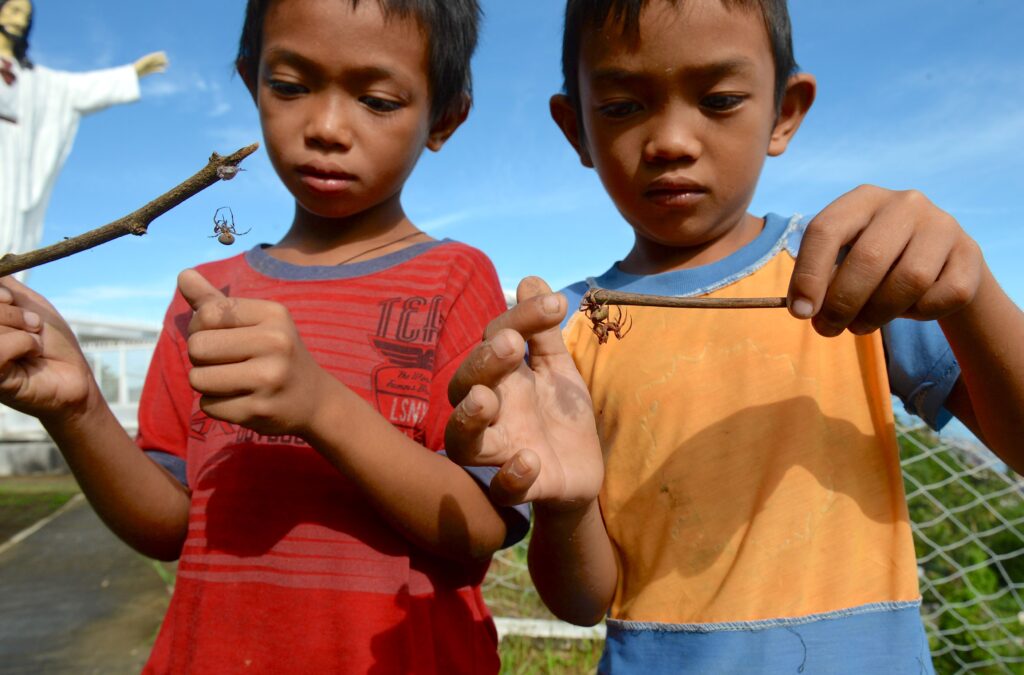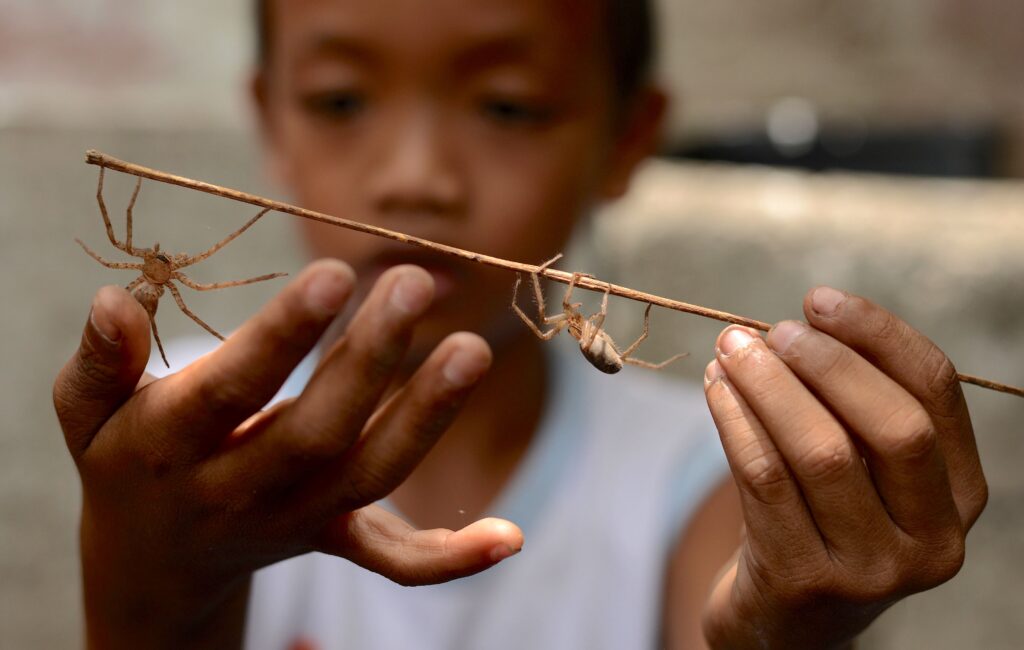What Spider Games Say About Arachnophobia
A fear of spiders, or arachnophobia, seems quite common around the world. Last year, a team of researchers published a global database showing the pervasiveness of arachnophobic sentiments in media based on their investigation of a decade of online newspaper coverage from over 80 countries. These fears remain even though less than 0.5 percent of spider species can actually harm humans through their venom, and most of these species live far from humans anyway.
But there are some exceptions—and my home country, the Philippines, is one of them.
One of the authors of the study, entomologist Aimee Lynn Barrion-Dupo, is also from the Philippines. In an interview, she explained that unlike most countries where spiders were depicted as sources of venom and harm, in the Philippines spiders figured in news reportage mostly as pets or as participants in the popular pastime of laro ng gagamba (literally “game of spiders”). The game involves catching spiders, taking care of them, and making them fight other spiders.
I know the game very well. When I was a child growing up in Laguna province in the Philippines, I played it with other kids in my neighborhood.
My father taught at the University of the Philippines Los Baños College of Forestry, which was located on Mount Makiling, some 60 kilometers away from Manila. Those of us who grew up on the slopes of the mountain would go into the forests to look for the fiercest, strongest, and most unique spiders. We would then house them in medicine bottles or matchboxes, and feed them ants, grasshoppers, and other insects—until it was time to play.
When two of us were ready to fight, we would place our spiders on the opposite ends of a stick of walis tingting, a kind of broom. Another person, who acted as a referee, was usually asked to hold the stick. Then, we’d nudge our spiders to walk toward one another and fight. The winner of the wrestling match was decided very quickly, sometimes within seconds or at most a few minutes. It ended when one of the spiders was killed or incapacitated, or when a spider either fell off the stick or tried to run away more than once.
We had names for the different spiders we commonly caught: gagambang botchog (round spider), gagambang pari (priest-like spider), gagambang ekis (spider with an X). Sometimes we would give them nicknames based on their appearances: gagambang pula (red spider) or Voltes V (after a Japanese anime character).
Could it be that this game desensitized us to spiders, making us less fearful of them in contrast to many other parts of the world?
This question interests me not just because of nostalgia for the spiders of my childhood but as an anthropologist who today explores human entanglements with other species. I’m fascinated by how we perceive and live with other creatures, including animals we pit against each other and play with—from cockfighting in Bali to bullfighting in Spain to cricket fighting in China.
When it comes to widespread fears surrounding spiders, a closer look reveals a more complicated picture of human responses and interactions with these creatures. The arachnologist David Wise, for instance, surveyed folk tales from North America to Africa that cast spiders in a positive light, leading him to conclude that not all societies are arachnophobic.
In the Philippines, a handful of scholarly accounts of laro ng gagamba depict people’s close relationships with spiders. Some of these detailed accounts remind me of my childhood days, while others go beyond my own experiences, showing how diverse and sophisticated the practice is across the country.
One example comes from an ethnographic account by cultural anthropologist Ty Matejowsky, who researched spider wrestling in Pangasinan province in Northern Luzon in the early 2000s. He recounts how boys and young men collect, train, and play with spiders, often for money. Although my experience of laro ng gagamba didn’t involve placing bets, Matejowsky sees the game as an entry point for many Filipinos into “gambling culture.” (He also presents the practice as exclusive to boys and men, but I remember playing it with neighbors who were girls.)
Matejowsky also details how players attempt to heal their spiders who may be hurt in battle. “As surprising as it may seem,” he notes, “steps can be taken to rehabilitate injured spiders for an eventual return to wrestling.” For instance, players place the leaves of ampalaya (bitter gourd), thought to have restorative properties, in the spider’s box for a few days before slowly resuming the regular diet of “insects and bits of meat and rice.”
Barrion-Dupo, with two biology colleagues, conducted a survey of 300 spider game players in Northern Mindanao from 2014 to 2015 that revealed more details of the practice. Gambling on laro ng gagamba matches, the investigators found at the time, could involve sums of up to 10,000 pesos (around US$180).
Fascinatingly, the researchers also recorded various substances people fed to the spiders to prepare for a fight. The list included various vitamins and supplements, dextrose, coconut water or meat, duck egg soup, Jujube plum fruit (Ziziphus jujuba), milk, honey, energy drinks, and even human breastmilk. The gamers usually placed these substances on cotton balls and left them in the boxes where the spiders were kept.
These details show that more than just a game, spider wrestling in the Philippines involves care and intimacy between humans and spiders. Matejowsky describes it as an “attachment … that approaches what some feel for more conventional pets.”
Today laro ng gagamba continues to be played in rural areas in some parts of the country. Barrion-Dupo sees the spider game as offering children “first steps in science and natural history,” ultimately contributing to an appreciation not just for spiders but for the environment at large.
However, the research by Barrion-Dupo and her colleagues also shows the game has a potentially detrimental impact on the populations of various spider species. Gamers usually extract mature reproductive females from the wild; female spiders, as it turns out, are more ferocious than their male counterparts. The researchers call for policies to restrict the game to prevent species decline.
As far as I know, spiders are not often included in animal rights discourses in the Philippines. (Matejowsky’s article noted spiders are considered “pests, not animals.”) However, these attitudes may change in the future; some people are already discussing the need to expand animal welfare concerns to include insects, spiders, and other invertebrates.
Even without active intervention, however, the game already seems to be declining in popularity.
When I recently returned to the neighborhood where I grew up, I was told that none of the kids ventured into the forests like my friends and I used to. During the pandemic, people were forbidden to go outdoors, and many public green spaces were off-limits for recreational activities. Plus, the advent of electronic gadgets and digital technologies has meant that children today, whether they live in urban neighborhoods or mountainous communities, are far more likely to be familiar with Spider-Man than the spiders that share their environments.
Regardless of the ultimate fate of laro ng gagamba, however, I hope our familiarity and fascination with spiders will continue.



































